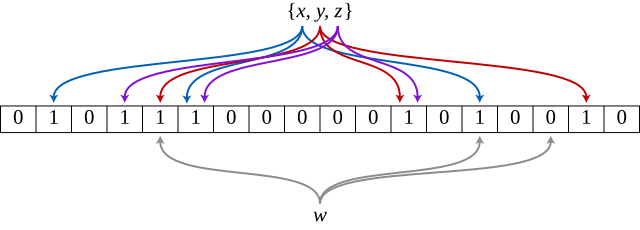Bloom Filters for Table Lookups
What is a bloom filter? A Bloom filter is a bit-array of a fixed size m. A (hash-) function is defined, which gives k different values within the range [0...m-1]. Two functions are defined on this structure, add() and lookup()
Pseudo-Code for a m=1024, k=3-Bloom Filter:
var filter [1024]bool
func hash(key string) (k0,k1,k2 int)
func add(key string) {
k0,k1,k2 := hash(i)
filter[k0] = true
filter[k1] = true
filter[k2] = true
}
func lookup(key string) bool {
k0,k1,k2 := hash(i)
return filter[k0] && filter[k1] && filter[k2]
}
A Figure of a m=18, k=3-Bloom Filter.

Using a Bloom Filter for Table Lookups
Let’s apply these Rules to a Table. In this (stupid) example, we have one key-value pair per row and one key per bloom filter. Our bloom filter will be m=1024, k=3!
-- SQL-Pseudocode.
CREATE TABLE bloom_table_v1 (
row_bloom bit[1024], -- per-row bloom filter.
row_key text,
row_value text
);
Now, lets code a Lookup.
SET lookup_key = ?::text;
SET k0,k1,k2 = hash(lookup_key);
SELECT row_value FROM (
SELECT * FROM bloom_table_v1
WHERE row_bloom[k0] AND row_bloom[k1] AND row_bloom[k2]
) WHERE row_key = lookup_key;
Now lets code another table, where we have multiple key-value pairs per row.
-- SQL-Pseudocode.
CREATE TABLE bloom_table_v2 (
row_bloom bit[1024], -- per-row bloom filter.
row_kvs hstore
);
And the lookup code for this.
SET lookup_key = ?::text;
SET k0,k1,k2 = hash(lookup_key);
SELECT row_kvs[lookup_key] FROM bloom_table_v2
WHERE row_bloom[k0] AND row_bloom[k1] AND row_bloom[k2];
Using compressed Bitmaps
So, while the algorithm showed above is a stupid linear search, we can represent the 1024-wide bit-array as a collection of columns (row_bloom[0],row_bloom[1],...,row_bloom[1022],row_bloom[1023]), each represented as a compressed bitmap (such as Roaring Bitmaps), on which boolean set-operations can be computed efficiently.
Using this technique, in some cases, we can achieve a considerably greater performance and compactness, than the use of a B-Tree. This technique can also handle sparse indeces with ease.
Note: The write-performance can be considerably lower, as we need to update alot of columns on every insert.
